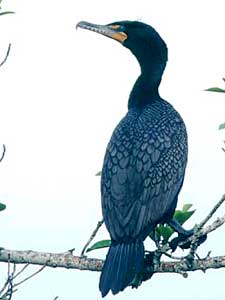|
Photos
Resources
Your Voice
|
Trying to control the cormorant
May 14, 2004
 |
| The cormorant population is booming, and some anglers say they're competing too hard for fish. (Photo courtesy Steve Mortensen, Leech Lake Band of Ojibwe) |
Duluth, Minn. — Knife River is the biggest spawning ground for rainbow trout on the North Shore of Lake Superior. Robin Whaley often fishes here and watches the cormorants on Knife Island, a half-mile offshore. Whaley is a retired biology teacher, she and her husband live nearby.
She's been keeping an eye on the booming population of cormorants on the island. About a hundred cormorants lived here last year.
"I guess they're just coming up into this area in the last few years and becoming a problem," says Whaley. "They're degrading habitat and eating little fish.
 | |||
The DNR has been stocking rainbow trout here for years. This year they put 40,000 young fish into the Knife River. Anglers like Robin Whaley hope the little fish will grow big enough for them to catch someday.
The cormorants living on the island are just one threat among many for the little fish. But some people would like to reduce that threat.
It's illegal to kill cormorants. They're protected because they're a migratory bird. But a new federal rule says says if they're threatening a resource, people can fight back in a different way. For instance, fish farmers can get a permit to use noisemakers and scarecrows to keep cormorants from robbing their ponds.
Bill Paul runs the Agriculture Department's Wildlife Services Program in Minnesota.
He sent workers onto Knife Island to try to keep the cormorants from nesting. Their methods were pretty basic.
"We put up some flapping tarps in the wind, and a couple of yellow raincoat scarecrows," he says. "We also had ten flashing highway barricade lights, and a light siren device that goes during the night. "
The workers also used shotguns to hurl firecrackers at passing birds. They did this for two weeks during the cormorants' nesting season. Bill Paul says it wasn't easy to scare them away.
"They seem to be fairly smart birds and real persistent at coming back to Knife Island," he says. "So we're uncertain yet whether our activities are going to keep them off long-term."
Researchers had permission to kill ten cormorants to find out what they'd been eating. They found fish in the cormorants' stomachs all right. But not the kind most people like to catch.
 | |||
But that study was done before the hatchery released its big batch of young rainbow trout. Don Schreiner supervises the Lake Superior fishery for the DNR. He plans to look at more cormorants' stomachs after he stocks the Knife River with young trout.
"My guess is that cormorants are opportunists and if there's a small silver fish out there, just hanging out, and the cormorant has that available to eat, he'll eat it," Schreiner says. "The question becomes, is this a significant part of the population they're consuming, or isn't it?"
Researchers have been studying cormorants for years, and so far they haven't been able to prove the birds are harming wild fish populations.
John Pastor is an ecologist at the University of Minnesota Duluth. He says the study at Knife River won't prove anything useful either. He says it ignores the bigger picture. He says there could be lots of reasons why there aren't many steelhead, or rainbow trout.
"Changes in land use. All the adult steelhead out there eating the young-of-the-year steelhead. Maybe it's some pollutant in the lake. You never know," he says. "But it's easy to fix on the predator as the problem, because people see a cormorant dive down and come up with a fish, and they say to themselves, I could have caught that fish."
Pastor says even if the cormorants are eating lots of young rainbow trout, it doesn't necessarily mean the birds are hurting the overall trout population.
But the DNR's Don Schreiner wants to find out.
"We've spent a lot of money trying to put those fish in, and if they're being eaten before they even get a chance to grow up, that's a concern," Schreiner says.
Even for an angler like Robin Whaley, the concern about the trout is mixed with a feeling of respect for the cormorant.
"I admire the bird very much," she says. "But human beings, we're in the business of controlling habitats and populations, and this is just another case of that."
The ultimate question in this competition between predators is - who gets the trout - cormorants or humans?
|
News Headlines
|
Related Subjects
|
